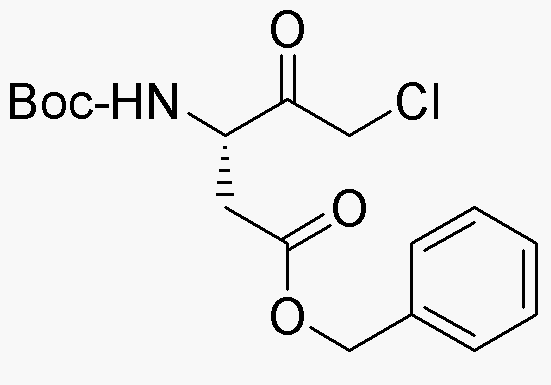Boc-L-aspartic acid b-benzyl ester chloromethylketone is widely utilized in research focused on:
- Peptide Synthesis: This compound serves as a key building block in the synthesis of peptides, particularly in the development of therapeutic proteins and enzymes. Its protective groups help in controlling the reactivity of amino acids during synthesis.
- Drug Development: It is used in the pharmaceutical industry for creating novel drug candidates. The chloromethylketone group can facilitate the formation of various bioactive compounds, enhancing the potential for new treatments.
- Bioconjugation: Researchers employ this chemical in bioconjugation processes, where it aids in attaching biomolecules to surfaces or other molecules, improving drug delivery systems and diagnostic tools.
- Research in Neuroscience: The compound is valuable in studies related to neurotransmitter pathways, particularly in understanding the role of aspartic acid derivatives in neuronal signaling.
- Material Science: It finds applications in the development of polymers and materials that require specific functional groups for enhanced performance, such as in coatings or adhesives.
Informations générales
Propriétés
Sécurité et réglementation
Applications
Boc-L-aspartic acid b-benzyl ester chloromethylketone is widely utilized in research focused on:
- Peptide Synthesis: This compound serves as a key building block in the synthesis of peptides, particularly in the development of therapeutic proteins and enzymes. Its protective groups help in controlling the reactivity of amino acids during synthesis.
- Drug Development: It is used in the pharmaceutical industry for creating novel drug candidates. The chloromethylketone group can facilitate the formation of various bioactive compounds, enhancing the potential for new treatments.
- Bioconjugation: Researchers employ this chemical in bioconjugation processes, where it aids in attaching biomolecules to surfaces or other molecules, improving drug delivery systems and diagnostic tools.
- Research in Neuroscience: The compound is valuable in studies related to neurotransmitter pathways, particularly in understanding the role of aspartic acid derivatives in neuronal signaling.
- Material Science: It finds applications in the development of polymers and materials that require specific functional groups for enhanced performance, such as in coatings or adhesives.
Documents
Fiches de données de sécurité (FDS)
La FDS fournit des informations de sécurité complètes sur la manipulation, le stockage et l’élimination du produit.
Spécifications du produit (PS)
Le PS fournit une description complète des propriétés du produit, notamment sa composition chimique, son état physique, sa pureté et les exigences de stockage. Il détaille également les plages de qualité acceptables et les applications prévues du produit.
Certificats d'analyse (COA)
Recherchez des certificats d'analyse (COA) en saisissant le numéro de lot du produit. Les numéros de lot et de lot se trouvent sur l'étiquette d'un produit, après les mots « Lot » ou « Lot de fabrication ».
Numéro de catalogue
Numéro de lot/série
Certificats d'origine (COO)
Ce certificat d'exploitation confirme le pays dans lequel le produit a été fabriqué, et détaille également les matériaux et composants utilisés et s'il est issu de sources naturelles, synthétiques ou autres sources spécifiques. Ce certificat peut être requis pour les douanes, le commerce et la conformité réglementaire.
Numéro de catalogue
Numéro de lot/série
Fiches de données de sécurité (FDS)
La FDS fournit des informations de sécurité complètes sur la manipulation, le stockage et l’élimination du produit.
DownloadSpécifications du produit (PS)
Le PS fournit une description complète des propriétés du produit, notamment sa composition chimique, son état physique, sa pureté et les exigences de stockage. Il détaille également les plages de qualité acceptables et les applications prévues du produit.
DownloadCertificats d'analyse (COA)
Recherchez des certificats d'analyse (COA) en saisissant le numéro de lot du produit. Les numéros de lot et de lot se trouvent sur l'étiquette d'un produit, après les mots « Lot » ou « Lot de fabrication ».
Numéro de catalogue
Numéro de lot/série
Certificats d'origine (COO)
Ce certificat d'exploitation confirme le pays dans lequel le produit a été fabriqué, et détaille également les matériaux et composants utilisés et s'il est issu de sources naturelles, synthétiques ou autres sources spécifiques. Ce certificat peut être requis pour les douanes, le commerce et la conformité réglementaire.


